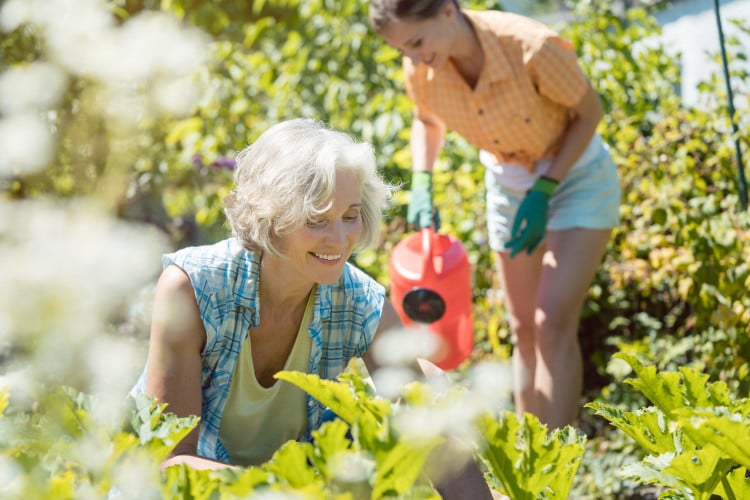Britons have traditionally used their gardens to grow medicines. In Shakespeare’s day, so called physic gardens where people grew their herbs for medicinal remedies were common.
I’m not suggesting you stop using proper medicine or seeing your doctor in favour of home produce. But you can explore simple herbal treatments like mint and chamomile tea infusions, growing your own garlic and using lavender to help keep clothes fresh and scent your baths.
Connecting with nature improves health, making us feel rejuvenated. So try these healthy contenders.
Healthy workout
Having a garden where the plants can benefit to your health is a real plus. But it’s not just the plants themselves, the very act of gardening also benefit mental and physical wellbeing.
From planting to digging to watering, gardening tones and strengthens a multitude of muscles. Plus, being outside gives you vitamin D from the Sun, which helps your body absorb calcium for strong bones and teeth.

And the sounds of the birds, bees and natural world has a calming effect on us.
Herbal helps

Mint helps your digestive system via fresh mint tea and can relieve bloating. In addition, you can use it for a homemade sunburn remedy.
Pour boiling water over three cupfuls of fresh mint leaves, then allow “phytochemicals” (biological compounds) from the mint infuse with the water. Strain the mint leaves out, leave to cool in the fridge, and then apply it to your sunburn.
Rosemary is a good source of vitamin B6 and helps boost the immune system. Eating rosemary with your food will also help improve concentration and your memory.
Beautiful parsley tastes great as a garnish on soup or in sandwiches and is known to support bone health and fight inflammatory allergic reactions.
Whereas something like chamomile, via fresh chamomile tea, is good for tackling skin irritation, but is of course better-known for aiding sleep.
Floral tones
Some herbs give you beautiful displays too. Feverfew is marvellous, with lovely foliage and it can help with headaches and migraines.
Traditionally, feverfew was used to treat fevers and other inflammatory conditions. In fact, it has come to be known as the “Medieval aspirin”. This aromatic perennial has daisylike flower heads that appear in summer but it’s the leaves which are normally dried for medicinal use.

Lavender is a really good antibacterial whilst aiding against fungal infection and there are some great ways to add it to jams and jellies. In your bath, a sprig produces a stunning scent, and wrapping dried sprigs in cloth to put in clothes drawers will deter moths and keep everything smelling sweet.
Lemon balm tea is good for circulation and is also a good palate cleanser. Growing well together, these plants are brilliant in sunny, well-drained borders.
Edible delights

The all-time favourite for growing in an apothecary garden is garlic which is great to fight against many ailments, including the common cold.
Grow it in a warm, sunny spot, in fertile, well-drained soil that doesn’t get too wet in winter. It goes great guns in containers too. Garlic contains sulphur compounds, formed when garlic is chopped, crushed or chewed – these help bolster immune systems through antioxidant properties.
The best thing about garlic, of course, is that you can easily incorporate it into your favourite dishes. Try garlic-fried shrimp, homemade garlic croutons with your soup or add some cloves to oil and let them infuse to drip over oven-roasted vegetables.
Practical tips
Ensuring there are plenty of healthy micro-organisms within the soil will be important for growing the most nutrient-packed apothecary.
Before planting, choose an area of your garden and dig it over as much as you can, removing any stones or weeds which will compete for nutrients. Then add in plenty of organic matter; things like farmyard manure, leaf mould, or even bags of soil conditioner from your local garden centre.

Ensuring the you crop the plants regularly is essential; otherwise they can get a little leggy.
Some people like to plant a herb wheel around a central focal point such as a sundial or a birdbath. Like spokes coming out, you can create a circular patch, with each section growing a different variety. Garlic in one compartment next to lavender, then feverfew, and so it goes on around the circle.
The one thing you should really do is position a seating area, such as an arbour with a bench where you can sit and relax, in your garden.
Tip:
When planting thirsty trees, sink a small upturned
pot right next to the trunk to fill with water that
will seep down to help keep the soil moist.
Being outside, enjoying the fresh air and peacefulness and simply spending time with nature is as important for your health as well as the plants.
Happy gardening everyone!
Reader questions
My lawn is looking dry – what should I do?

First do not cut your lawn short, let the blades of grass grow up to help it hold moisture (use your highest setting on the mower). Water the lawn if possible first thing in the morning or last thing at night to reduce evaporation. But grass is very hardy and even if it goes yellow, it’ll soon come green again when the rain returns.
I notice a build up of slug slime on my patio what should I do?

It’s a good idea to get rid of it because the slime trails indicate to other slugs that there is good eating there and so it will encourage others to feast on your plants. If you are not careful, the patio it will end up looking like the rail lines going into Waterloo station. So mix some vinegar with water and brush it away with a stiff brush.

Leave A Comment